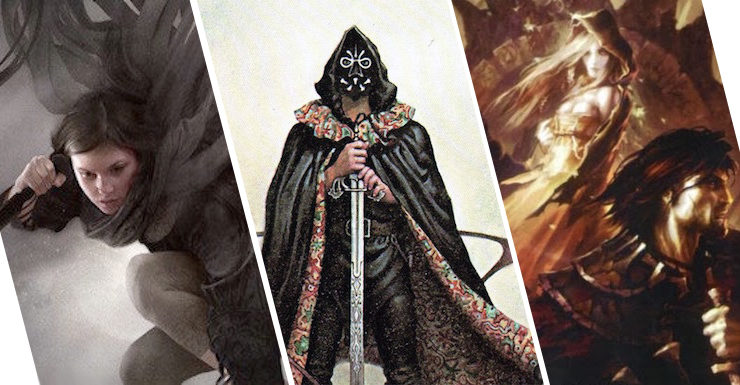Before diving into the list itself, I’d like to establish a few things: first, these are completely subjective rankings based on my own favorite series. The list takes into consideration things like prose, dialogue, characters, worldbuilding, and plot. In some cases, weight will be given more to phenomenal prose; in others, the focus will be on setting or characters or whatever the books’ major strengths happen to be.
It also ignores incomplete series, so you won’t see any love for The Kingkiller Chronicle or The Stormlight Archive, among others. Similarly, it ignores standalone books, so no Uprooted or The Windup Girl or Roadside Picnic.
Additionally, this list in many ways represents science fiction and fantasy of the past (mostly the late 20th century). It’s likely that a few of these will still be on my list in a decade, but SFF of the past few years has taken a much-needed turn toward more diverse viewpoints and voices. This means that I simply haven’t read some of the best new authors yet—and others, whom I have, don’t have their series finished. So while the largely male and white voices of the 1980-2010 era have provided some excellent groundwork, the future of science fiction and fantasy will undoubtedly feature more diverse voices at the top of the board.
For instance, I haven’t yet read the Broken Earth trilogy by N.K. Jemisin (which is by all accounts a stunning literary work). Authors like Jemisin are sure to figure into future lists of this sort…and the opportunity to find and read new stories from new voices is one of the most exciting things about reading SFF.
That said, let’s dive on in!
10. The Runelords (“Earth King” series) by David Farland
Buy the Book
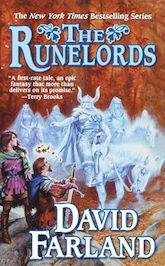

The Runelords
David Farland’s Runelords series occupies an interesting spot in the fantasy canon, especially for me. Perhaps because of the timing of my introduction to it, and perhaps because of the cover art, but I’ve always thought of Runelords as a more traditional series. Like The Wheel of Time, Runelords had cover art for most of the books done by the legendary Darryl K. Sweet.
Indeed, it was that cover art that led me to buy the first book, The Sum of All Men, in a little beachfront bookstore on vacation in Hawaii when I was 12. I saw something that looked like The Wheel of Time and jumped in with both feet.
I’m glad I did. Farland’s a talented writer, and he truly excels at giving depth to things that normally get glossed over in fantasy.
There are two main magic systems, for lack of a better term, in Runelords. The first involves a pretty standard elemental magic: you’ve got magic-users who can perform magic based around earth, air, fire, and water. There are some interesting applications here, but the genius in this series lies with the other magic system.
In this world, people can grant endowments—physical or mental attributes—to other people. Those who have acquired such endowments are called Runelords, and tend to be nobles or soldiers. After all, a warrior with the strength of five men and the stamina of three is going to be tough to fight on a battlefield.
Farland could have left the magic there and made the series somewhat interesting. Instead, he dug deeper, exploring the ethical, moral, and even economic implications behind such a system.
When an endowment is given to a Runelord, it’s transferred. Thus, if a Runelord wants the sight of two men, his Dedicate will be left blind, and the endowment only works for the Runelord while the Dedicate is living.
The result is tremendous expense given to keep Dedicates alive. The giving of endowments like grace (the ability to relax muscles), brawn (the ability to flex them), and stamina leaves such Dedicates in extremely fragile states. A Dedicate who gave stamina, for instance, is susceptible to disease.
On top of that, Runelords are almost unstoppable in battle, except by other similarly powered Runelords. Instead of facing them down on the field, strategy has evolved to focus on assassins, who try to break into Dedicates’ Keeps and kill the helpless Dedicates, weakening Runelords out on the field. It’s a fascinating look at all of the implications of the way this magic works.
I should note that while, technically speaking, the extended series as a whole will run nine books, it’s really split into two: the first four books comprise the “Earth King” series, and the next four (and forthcoming fifth) comprise the “Scions of the Earth” series. The first four are where Farland’s story and world work the best.
9. The Harry Potter Series by J.K. Rowling
Buy the Book
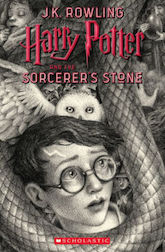

Harry Potter and the Sorcerer’s Stone
As one of my friends noted when I mentioned this list to her, “one of these things is not like the others.”
Harry Potter may be aimed at a younger audience than the rest of the series here, but it is without a doubt one of the most influential series of the last 30 years.
Sure, Rowling’s writing is a bit elementary during the first few books, but it improves as the series goes on. Her worldbuilding is excellent (despite post-publishing missteps), the characters are undeniably vibrant, and the plotting is, for the most part, tight.
Most impressive, however, is the pacing of these books. There truly isn’t much wasted space, even in the 800-plus-page The Order of the Phoenix. They are eminently re-readable, buzzing along at a healthy speed and filled with moments of thrills, sadness, and exuberance.
8. The Mistborn Trilogy (Era 1) by Brandon Sanderson
Buy the Book
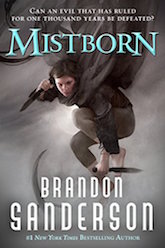

Mistborn: The Final Empire
The only completed series in Sanderson’s Cosmere deserves a place in this list. While many of the series that I have ranked higher are there because of incredible prose or vibrant characters, Sanderson’s strength lies in his worldbuilding.
Scadrial is perhaps the most “traditional” of the worlds in the Cosmere, with the typical medieval tech and armies of high fantasy. But Sanderson’s world around those staples is unique, with the mists and the ashmounts—and the Metallic Arts.
The three main types of magic used in Mistborn revolve around the use of metals to fuel (or steal) magic, with an intricate, thorough grounding. Mysteries are explored and revelations abound, remaining satisfying and surprising despite how logical they are.
While the second book, The Well of Ascension, suffers from pacing issues and a bit of a lackluster conflict through the first two-thirds, its final third and climax are truly outstanding work—some of Sanderson’s best.
The Hero of Ages presents the kind of bombastic conclusion hoped for, with twists, surprises, and a beautiful, bittersweet ending. By all accounts, Era 2 of Mistborn is even better, but that review will have to wait for the release of The Lost Metal, expected sometime in late 2019.
7. The Lord of the Rings by J.R.R. Tolkien
Buy the Book
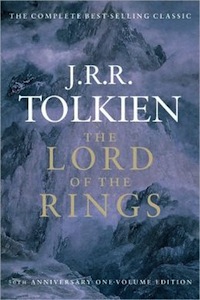

The Lord of the Rings
This may be a somewhat controversial pick; or it may not. Either way, Tolkien’s famed trilogy holds a special place in my heart. Lord of the Rings is not the best-paced story, nor the most intricate, but it does several things extraordinarily well.
The way Tolkien handles tropes is straightforward but meaningful: Samwise Gamgee, for instance, truly is the hero of the story. It’s not Aragorn or Legolas or Gimli, of course, but neither is it Frodo. Samwise is the ultimate sidekick, because at the root of the story, he’s not a sidekick.
Tolkien’s prose gets knocked fairly often, though I don’t mind it. But where he really knocks it out of the park is with his dialogue. The elevated language flows beautifully, and there are some absolutely fantastic conversations and exchanges in these books. Take Gandalf’s encounter with the Witch King inside the gates of Minas Tirith:
In rode the Lord of the Nazgûl, under the archway that no enemy ever yet had passed, and all fled before his face.
All save one. There waiting, silent and still in the space before the Gate, sat Gandalf upon Shadowfax: Shadowfax who alone among the free horses of the earth endured the terror, unmoving, steadfast as a graven image in Rath Dínen.
“You cannot enter here,” said Gandalf, and the huge shadow halted. “Go back to the abyss prepared for you! Go back! Fall into the nothingness that awaits you and your Master. Go!”
The Black Rider flung back his hood, and behold! he had a kingly crown; and yet upon no head visible was it set. The red fires shone between it and the mantled shoulders vast and dark. From a mouth unseen there came a deadly laughter.
“Old fool!” he said. “Old fool! This is my hour. Do you not know Death when you see it? Die now and curse in vain!”
Not many writers can craft something so smooth, foreboding, and powerful. Similar scenes between Eowyn and the Witch King, and between Aragorn and the Mouth of Sauron, stand out.
The Silmarillion technically doesn’t belong here, but I must note that it is also a tremendous bit of storytelling in a different style. The tales in the Quenta Silmarillion vary from exciting to romantic to outright heartrending (looking at you, Túrin Turambar…).
6. The Ender Quartet/Shadow Quartet by Orson Scott Card
Buy the Book
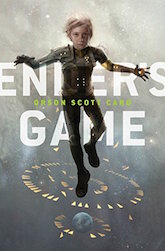

Ender's Game
I struggled with whether or not to split these into two series, since they really do follow two separate (but intertwined) stories. In the end, I felt that the way Card has written in new novels since completing the main quartets shows he considers them more connected.
Ender’s Game is certainly one of the most popular science fiction novels ever written, and for good reason. It resonates with younger audiences, while exploring themes and morality suitable for any adult. The subsequent Ender books carry forward that more adult-oriented focus.
Speaker for the Dead remains the single best science fiction book I’ve ever read, and while Xenocide and Children of the Mind do not maintain that lofty standard, they at least give a decent conclusion to the series.
Meanwhile, the Bean installments are uniformly excellent. Ender’s Shadow was a brilliant idea, and the way the subsequent Shadow books handle the characters of Peter Wiggin and Petra Arkanian is wonderful.
5. The Acts of Caine by Matthew Woodring Stover
Buy the Book
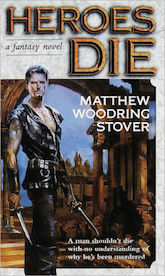

Heroes Die
Like The Gap Cycle by Stephen R. Donaldson, Stover’s quartet can get rather gruesome at points. It’s the kind of no-holds-barred adventure story that fantasy often aspires to be, but misses. It’s grimdark, but not for the sake of being grimdark.
Starting with Heroes Die, Stover’s series blends science fiction and fantasy: in the far-future of Earth, the world finds its entertainment in the recorded Adventures of Actors, sent by inter-dimensional technology to a fantasy world called Overworld, inhabited by elves and dragons, wizards and ogrilloi.
As the series goes on, it becomes clear that the fates of Overworld and Earth are more intertwined than people believed, and Hari Michaelson, a.k.a. Caine, is at the center of it all.
The characters are truly what shine in Stover’s series. His prose is excellent, riddled with fight scenes and one-liners to make any reader laugh, but the most impressive part is how he molds a wide cast of characters.
Caine is, of course, the focus. However, his estranged wife Shanna (or Pallas Ril, as she’s known on Overworld) is a deeply interesting woman with psychological depths of the kind rarely explored in other series. The antagonists are at turns pure evil and startlingly sympathetic. Arturo Kollberg, Hari’s boss on Earth, undergoes one of the most shocking transformations you can imagine. Ma’elKoth, the god-emperor of Ankhana on Overworld, is ruthless yet tender.
Most of all, The Acts of Caine is an ambitious series. Heroes Die is a near-perfect adventure novel, with sublime pacing and a cathartic climax. The Blade of Tyshalle follows up Heroes Die as a flawed masterpiece.
In Blade, Stover plays with mythology and legend while taking the old authors’ maxim “think of the worst thing you can do to your protagonist, and then do it” to 11. It is in this book that we see the darkest depths of characters; it is also here where we see hope shine the brightest.
The third book, Caine Black Knife, is an unadulterated love letter from Stover to Caine, covering his most famous Adventure. The final book, Caine’s Law, is a runaway roller coaster, full of bombastic twists and mind-boggling revelations.
The Acts of Caine is, at heart, an adventure story—but one with all the trappings of high literature already in place. It allows the reader to enjoy the thrill of the action, but also forces you to consider the entertainment you’re consuming, and what it means to consume it.
4. The Gap Cycle by Stephen R. Donaldson
Buy the Book
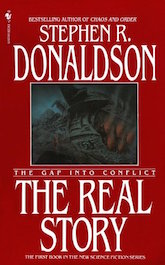

The Real Story: The Gap Into Conflict
Donaldson’s Gap Cycle is my highest-ranked pure sci-fi series. This is the peak of space opera, as far as I’m concerned.
The five-book series starts with a shorter volume: The Real Story is basically a novella, laying the groundwork for the fireworks to come. It tells a story from several different perspectives, showing how point-of-view impacts what people might think of as “the real story.”
Donaldson’s clever introduction explodes in the second installment, Forbidden Knowledge. From here, the series just gets more intense, more tightly woven, and develops ever-increasing stakes.
The Gap Cycle is, in fact, probably the only series I’ve ever read where each book is demonstrably better than the last. The final book, This Day All Gods Die, was a white-knuckle thriller from page one to the epilogue—on top of having one of the most incredible titles I’ve ever seen.
(Content of the stories aside, Donaldson’s titles are just fantastic. A Dark and Hungry God Arises? Awesome. This Day All Gods Die? Hell yeah.)
This series has one major knock, and that’s the subject matter. The first two books especially deal with graphic violence, of both sexual and psychological natures. It can get pretty tough to read at points. Despite that, it’s an incredible story, well-written, with some of the most complex and layered characters in science fiction.
3. The Book of the New Sun by Gene Wolfe
Buy the Book
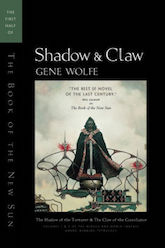

Shadow & Claw
Gene Wolfe is probably the most decorated, celebrated, and accomplished SFF writer that most people have never heard of.
(Okay, that’s a little bit of an exaggeration. But not by much.)
Wolfe’s four-part Book of the New Sun is a monumental literary accomplishment. His use of symbolism, metaphor, an unreliable narrator, and constant foreshadowing beggars anything that Robert Jordan or George R.R. Martin have ever done.
Wolfe’s story is compelling, but unorthodox. The pacing of the series—especially in the first two books—is strange, as the narrative meanders about, touching on seemingly inconsequential events and glossing over (or leaving out entirely) big action scenes.
But the action and adventure isn’t the point. Wolfe’s writing is so rich and his storytelling so involved that he grips you and pulls you along in a riptide of language and mystery.
The Book of the New Sun is a challenging read, to be sure. Archaic language abounds, and layered storytelling forces the reader to pay attention, smarten up, and read more critically.
My favorite part of Wolfe’s work is his writing, though. The way he uses words, conjuring everyday images in beautiful ways, is unparalleled among writers I’ve read (really, only Kai Ashante Wilson is even in the same conversation):
How glorious are they, the immovable idols of Urth, carved with unaccountable tools in a time inconceivably ancient, still lifting above the rim of the world grim heads crowned with mitres, tiaras, and diadems spangled with snow, heads whose eyes are as large as towns, figures whose shoulders are wrapped in forests.
Who else would describe mountains like that? Who else would turn such an everyday writing opportunity into lyrical, evocative imagery?
I think it says a lot that, after I finished Citadel of the Autarch, I couldn’t make myself read any other authors for almost two months. Everything just felt bland after the richness of Book of the New Sun.
2. The Black Company by Glen Cook*
Buy the Book
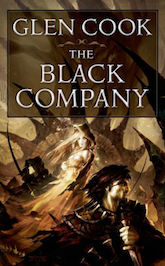

The Black Company
Glen Cook is a lesser-known name, but his mark on fantasy is everywhere. His knack for approaching the grittier, more down-to-earth aspects of fantasy inspired the grimdark genre. The Black Company itself eschews the deep worldbuilding of Jordan or Martin or Sanderson, instead concentrating on the day-to-day stories of soldiers in the mercenary Black Company.
Tropes are twisted on their heads, humor abounds, and settings move from standard European fare to vibrant Middle Eastern analogues and beyond.
The Black Company is a rollicking good time, interspersed with creepy demons and eldritch castles, mad wizards and the horrifying conditions of besieged cities.
This series features some of my favorite characters. Whether it’s the snarky Croaker, brooding Murgen, competent Sleepy, or the irrepressible Voroshk girls, there’s a wide and diverse cast. Not only that, but the emotional impact built up over the course of ten books leaves the reader stunned at the end of Soldiers Live.
It’s that lasting impression from the end of the series that sticks with me—it’s the most perfect series ending I’ve read.
As Croaker says at one point, “Memory is immortality of a sort.” The Black Company left this reader with indelible memories.
*The full narrative arc of the series is completed in Soldiers Live, but Cook may not be totally finished just yet. Port of Shadows, a sort of “interquel” between books one and two, was recently released. Another book has long been rumored, called A Pitiless Rain.
1. The Wheel of Time by Robert Jordan (and Brandon Sanderson)
Buy the Book
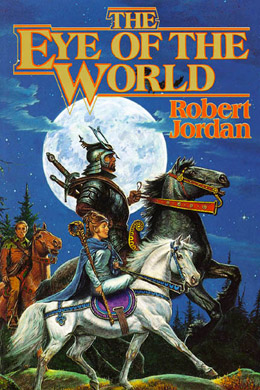

The Eye of the World
I almost feel bad about how little there is to say in this section. When it comes down to it, I can’t do justice to this series in a list review. The meat, the immersion, the pure reality of reading Robert Jordan’s magnum opus is something that must be experienced to be understood.
The Wheel of Time is one of the preeminent fantasy series of the late ’90s/early 2000s. Jordan was an absolute titan of fantasy, with his books selling upwards of 80 million copies, according to some sources.
Jordan took Tolkien’s legacy and transformed it for the modern era. The series purposely starts in a similar, familiar fashion, but rapidly comes off the rails and grows into its own monster. The level of worldbuilding is incredible, down to histories, cultures and customs, genealogies and magic.
The Wheel of Time defined a generation of fantasy. Robert Jordan didn’t turn out sparkling prose like Gene Wolfe, but he certainly had his moments. His characters aren’t necessarily as compelling as those in The Acts of Caine or The Black Company, but they’re nonetheless rich, dynamic, and feature the kind of warmth that makes readers consider them friends. The Wheel of Time is, in its way, the complete fantasy package.
Drew McCaffrey lives in Fort Collins, CO, where he is spoiled by all the amazing craft beer. You can find him on Twitter, talking about books and writing, but mostly just getting worked up about the New York Rangers.










